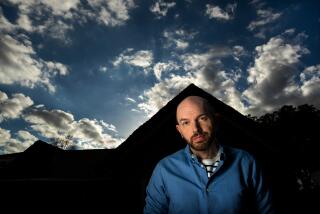ART : Inside the Outsider : Artist Mindy Alper reveals the dark paths of her mind through the compulsiveness of her imaginative drawings
- Share via
From the time she was very young, Mindy Alper knew she was different from other people.
“I was a strange child,” the 33-year-old artist recalls during a meeting at the house in Mt. Washington where she’s lived for five years, surrounded by thousands of artworks she’s created over the course of her life.
“As a child, one doctor diagnosed me as autistic, but I’m not sure that was at the root of my problem. All I know is I had a hard time learning, I couldn’t stand to have people touch me, and I began drawing when I was 1 and have never stopped. Drawing is like smoking cigarettes--it’s a compulsive habit, and my anxiety level goes up considerably when I’m not drawing. When I was a kid, I thought art was this place you could go where anything could happen and nobody was ever mad at me. It was, and still is, the only place I felt safe.”
A self-taught artist who’s spent her life straddling the magical world of art and the dark realm of deep depression, Alper has turned out a stunningly powerful series of drawings, paintings and sculpture that take the viewer on a harrowing journey through the labyrinth of her mind.
Alper has never heard of Outsider art (a loosely defined creative school encompassing the work of visionaries, psychotics and self-taught artists who work in conditions of extreme isolation), which is currently the subject of “Parallel Visions: Modern Artists and Outsider Art,” a major exhibition at the Los Angeles County Museum of Art. Outsider is, however, the appropriate tag for Alper’s work because, for her, art has been more than a way to express herself or make a living and decorate the world--it’s been a critically important survival tool.
Art became even more important to Alper in 1986 when she had the major breakdown that had been building up since her childhood and she lost the ability to speak or write. Hospitalized for several months, she used drawing as the primary means of communicating with friends and therapists, who looked to her artwork as a valuable diagnostic tool.
Working with a hypnotist, Alper regained the ability to speak. However, during the past six years she’s lapsed into silence several times for varying periods of time. These episodes are usually triggered by a traumatic event, and when a close friend died in July, she stopped speaking for the second time this year. This episode lasted considerably longer (three months) than previous periods of silence, so she developed a system of whistling that close friends came to understand, and invented a “word box.” A set of 500 printed words cut out from various sources and arranged into 21 color-coded categories, the word box allows her to form sentences and thus communicate.
Interviewing Alper through her word box is at once extraordinary--the crude sentences she assembles are quite poetic--and difficult. Facilitating the interview is Alper’s good friend, actress Catherine Coulson (best known for her portrayal of the Log Lady on “Twin Peaks”), who describes herself as “Mindy liaison.”
“I got to know Mindy several years ago when I came to have her help me draw a log, and we really connected,” says Coulson, whose husband, Marc Sirinsky, met Alper in 1986 when he was director of the Imagination Workshop, a group of theater artists who worked in psychiatric hospitals and prisons.
“Mindy has a big network of supportive friends who really love her because she’s a lot of fun,” says Sirinsky, who’s working on a play in which figures from Alper’s drawings come alive on stage.
Among that supportive network is Susan Arnold, a film producer and director who met Alper through the Imagination Workshop. The producer of “Benny and June”--a film scheduled for release in the spring that explores the relationship between an emotionally disturbed artist, played by Mary Stuart Masterson, and her brother, played by Johnny Depp--Arnold arranged for Masterson to spend time with Alper when she was preparing for the film. “Mostly we just looked through my hundreds of drawings and talked about them,” Alper says of the time they spent together in June.
Alper’s personality is marked by a self-effacing humor and charming guilelessness that combine with the grave sadness on her face in a manner that’s quite compelling. A gracious hostess who is eager to be accommodating, she nonetheless shows her work with modesty and embarrassment. “I can count the number of times I’ve shown my work on Django Reinhardt’s hand,” she shyly quips.
Alper is also obviously uncomfortable with the process of being interviewed. Frustrated by the limitations of her word box and concerned that she protect the privacy of her family, which she acknowledges played a role in the psychological problems she struggles with, she grows increasingly agitated as the interview drags into the second hour. When it becomes clear that the interview is upsetting her, the reporter lets her off the hook, figuring the gaps in her life story can be filled in by her friends.
Two days later, the reporter receives a phone message from someone speaking softly and with considerable difficulty: “Hi. This is Mindy Alper. Call me if you’d like to talk to me.” We meet and begin the interview again. The first question, of course, is: “How did you get your voice back?”
“For the last few months I’ve been having intense anxiety attacks that cause my body to go into convulsions,” explains Alper, who also suffers from agoraphobia and anorexia. “They usually last a few hours, but this one was so intense it caused me to go in and out of consciousness. I hadn’t been able to eat for a couple of days prior to the attack, and I was weird all day before it happened. I got to group therapy and noticed I was getting really shaky and went into another room and started having convulsions, so they took me to the hospital.
“The attack continued with my body going through intense contractions until it could no longer sustain that level of tension, and as it progressed I began making guttural sounds that eventually began to take the shape of words. I’m glad I got my voice back because it depresses my dog when I’m not able to talk to him,” she adds with a smile. “I think dogs need to hear their name. But sometimes I really like the silence that envelops me when I’m not speaking, and I stop thinking in words. I’ll look at a chair and have no idea what the word for it is.”
Having given rebirth to her voice, Alper is now ready to tackle the story of her life. Born in Brooklyn, the second in a family of four children, she moved to Los Angeles with her family at age 2.
“My father was in the textile business, and my mother wanted to be a painter--she used to make paintings that she hid from us--but she stayed home and raised us instead. My parents were liberal and we were an unusual family--we were all musical,” says Alper, who plays violin and guitar. “I got migraines a lot when I was growing up and spent most of my time being really passive, then I’d totally lose it and blow up--somebody would touch me and I’d throw a chair across the room. My three brothers experienced the problems in our family in a different way--my being the only girl had something to do with how I reacted, and I was always oversensitive about everything from the time I was really little.”
Alper says chemical imbalances play a significant role in the depression that plagues her, and though chemistry may well play a role in her mental state, one could also make the case that certain children function as lightning rods in their families, attracting and absorbing unexpressed conflicts and psychological toxins that leave their siblings comparatively unmarked. This certainly seems to be the case with Alper.
“From the time I was very little, all I wanted to do was draw, so my parents sent me to take art lessons when I was 5 from this woman named Dorothy Cannon who had a huge impact on my life--Dorothy’s house was a world of pure art and wildness,” Alper remembers. “Because of Dorothy, my work has been influenced more by music than by visual art--she played all kinds of stuff for us and used to read us nonsense books by Lewis Carroll and Edward Lear. That stuff made a big impression on me too.”
“Mindy already knew how to draw when she came to me and had a style completely her own,” says Cannon, who lives in North Hollywood. “She was born with a photographic memory and had an unusual capacity for dipping into her subconscious and doing drawings from that point of view. Knowing her as well as I do, I know that she’s suffered a great deal and that art has saved her life.”
Alper still has several of her drawings from early childhood, and they are remarkably sophisticated in their technical polish and psychological complexity. She also began making sculpture at the age of 5.
“Dorothy gave me a big bucket of what I thought was oatmeal and grabbed my hands and stuck them in the bucket and we made this really grotesque mask,” Alper says. “Masks turn up repeatedly in my work, probably because the idea of having something to hide behind appeals to me. I started out making masks, then I started making people and they got bigger and bigger. For a while when I was a kid, I made really intricate marionettes that took me months to finish. I wanted to have control over something and I had control of my marionettes--but, oddly enough, I never played with them. I always gave them away shortly after I finished them.”
If Alper’s childhood was difficult, her teen-age years were even worse. “I was very depressed during that period of my life and contemplated suicide constantly,” says Alper, who continued to make a prodigious amount of artwork during those years.
“I went to the first public alternative school in L.A. (Highland Park), but they weren’t equipped to give me the help I needed. I couldn’t learn to read, which is something I still have difficulty with, and saw several bad doctors who made things worse. When I was 17, I left home and moved in with two friends for a year, then I went out on my own and lived in many different places and had various jobs. I went to school to learn carpentry and worked at that for a while, and I also worked as a typesetter in a print shop.”
In 1986, the depression Alper had struggled to keep at bay all her life engulfed her. “So many traumatic things happened that year,” she recalls. “I got hit by three cars in a period of two years by drunk drivers and was injured. My house was robbed three times, and my puppy got beat up. I was volunteering in a terminal teen-agers’ ward at Children’s Hospital, and though I loved it, it was very difficult. The day I had the nervous breakdown, I found out that one of my kids I really liked had AIDS, and that same week a very dear friend died.
“I could go on listing things that would be stressful for anybody, and having all that happen in combination with the darkness that had been building up for my whole life just made me blow apart. Every part of my body just went. I was like a building that had been put together without any foundation and I fell apart.”
Alper spent the next two months in a private psychiatric hospital, and on her release stayed for a period with friends before moving to the house where she currently lives. She’s been on a series of medications that have helped her in varying degrees, and has been supported by her family since her breakdown. Throughout the emotional roller coaster of the past six years, she’s continued to make art, usually working with music on and the television on with the sound off--”I like having the television on because it’s a way to go outside without leaving the house,” she explains.
“I’ve often wondered whether my creative drive would leave if I became ‘normal,’ because most of my art grows out of the need to express pain,” says Alper, who hates to travel and rarely visits galleries or museums. “If I weren’t in pain, would I go to the movies instead? Maybe. Would I be willing to make that swap? Yes. Actually, I don’t believe my creativity would leave if my pain were to lessen, because I’m still able to make things when I’m feeling good--it’s easier, actually.” Asked if she’s ever created an artwork out of a feeling of joy, she says: “Yes, I made a drawing like that once.”
Asked what she sees as the recurring themes in her work, she replies: “Chairs seem to turn up repeatedly, and to me they symbolize the state of waiting. I draw birds a lot too, and birds represent many different things. Technically I’d say my work is getting better because I know my materials better, and the content of the drawings has become more emotionally clear--they’re not just images scattered over a page anymore but are a very clear statement of what I’m thinking and feeling if you know how to read the language.”
When one comments that out of the hundreds of drawings she’s produced, there isn’t a single one without a human figure in it, Alper confirms that she never does abstraction or landscape.
“It’s hard for me to be in nature because I get overwhelmed by the beauty and it makes me fall asleep--I get migraines when I go to art museums, for the same reason,” she explains. “I find landscape extremely threatening. I have to live where there’s a view, but I won’t look at it, and when one of my friends drags me out into nature, I look at the mountains and trees and draw people. I study anatomy all the time and love watching people.”
In parting, one asks her which word in her word box is most important to her. After a long silence she replies: “There are two. I like fly because it makes me think of this great, soaring feeling, but it also makes me think of a bug,” she adds with a laugh.
“Everything’s a double-edged sword with me. I also like imagine because my imagination has been my life raft.”
More to Read
The biggest entertainment stories
Get our big stories about Hollywood, film, television, music, arts, culture and more right in your inbox as soon as they publish.
You may occasionally receive promotional content from the Los Angeles Times.










